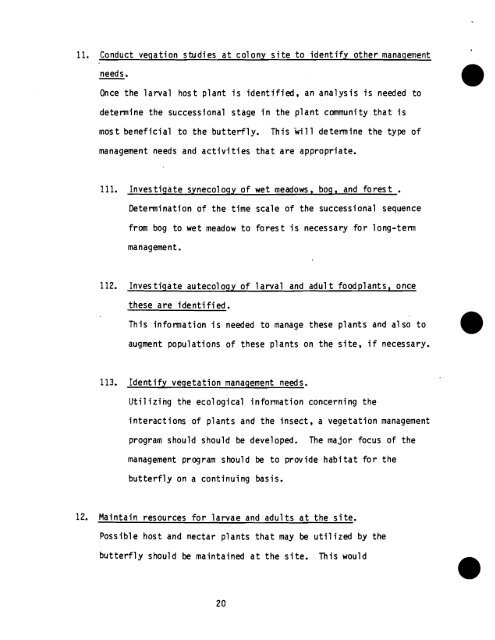Lotis Blue Butterfly Recovery Plan - U.S. Fish and Wildlife Service
Lotis Blue Butterfly Recovery Plan - U.S. Fish and Wildlife Service
Lotis Blue Butterfly Recovery Plan - U.S. Fish and Wildlife Service
You also want an ePaper? Increase the reach of your titles
YUMPU automatically turns print PDFs into web optimized ePapers that Google loves.
11. Conduct vegation studies at colony site to identify other management<br />
needs.<br />
Once the larval host plant is identified, an analysis is needed to<br />
determine the successional stage in the plant community that is<br />
most beneficial to the butterfly. This 'will determine the type of<br />
management needs <strong>and</strong> activities that are appropriate.<br />
111. Investigate synecoloqy of wet meadows, boq, <strong>and</strong> forest .<br />
Determination of the time scale of the successional sequence<br />
from bog to wet meadow to forest is necessary for long-term<br />
management.<br />
112. Investigate autecol ogy of 1 awal <strong>and</strong> adul t foodpl ants, once<br />
these are identified.<br />
This information is needed to manage these plants <strong>and</strong> a1 so to<br />
augment populations of these plants on the site, if necessary.<br />
113. Identify vegetation management needs.<br />
Util izing the ecological information concerning the<br />
interactions of plants <strong>and</strong> the insect, a vegetation management<br />
program should should be developed. The major focus of the<br />
management program should be to provide habitat for the<br />
butterfly on a continuing basis.<br />
12. Maintain resources for larvae <strong>and</strong> adults at the site.<br />
Possible host <strong>and</strong> nectar plants that may be utilized by the<br />
butterfly should be maintained at the site. This would

















